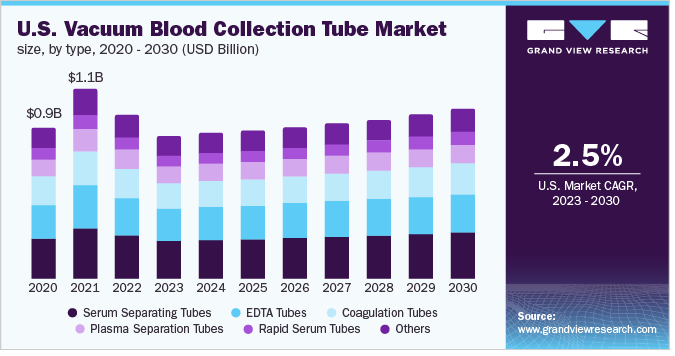Vacuum Blood Collection Tube Market Growth & Trends
The global vacuum blood collection tube market size is projected to reach USD 3.20 billion by 2030, registering a CAGR of 3.02% during the forecast period, according to a new report by Grand View Research, Inc. Increasing prevalence of chronic and infectious diseases, a growing number of blood transfusions, coupled with rising hematological disorders are boosting the adoption of blood collection tubes. In addition, frequent disease outbreaks in endemic areas are anticipated to increase the demand for blood collection tubes for clinical diagnostics. The market is anticipated to witness rapid growth owing to the factors, such as the growing need for the identification of infectious agents, cancer biomarkers, cardiovascular diseases, women’s health issues, and substance abuse.

A blood test is performed for numerous indications, such as infection, anemia, hypokalemia, leukemia, and kidney function. Lab diagnostics, relying on diagnostic tests to commence the treatment of any disease condition, has played a substantial role in the demand growth of the tubes. In addition, contagious diseases have made the most important impact on any cause of hospital admissions. Currently, emerging and re-emerging infectious diseases are presenting public health danger. For instance, as per the WHO, almost 1.2 million people in the U.S. have HIV. Vacuum tubes are used routinely for the collection of blood specimens in laboratory diagnostics, globally. They have numerous advantages over the traditional method of drawing blood with the use of syringes as the closed vacuum tube assures phlebotomist safety and clean specimens due to minimal transferring and touching.
They are safer and easier to use and come with pre-added additives. The stopper’s color coding is common, which makes it effortless to communicate and understand the medical community. Moreover, it also permits many tubes to be filled in one sitting; thereby lowering the chance of hemolysis. Vacutainers have other advantages as well, such as increased proficiency in diagnostic tests, shortened time of blood draws, and reduced needlestick injuries & risk of contamination. The COVID-19 pandemic has had a positive impact on industry growth owing to the increased government support for exploring the possibilities of allowing laboratories to enhance the blood testing process. However, since the beginning of the pandemic, the healthcare industry has been facing several challenges.
Currently, BD’s specimen management business is challenged by a high demand for blood collection tubes, further challenging the company’s capability to supply products and achieve necessary raw materials for its manufacturing plants. However, leading players expanded their manufacturing capabilities to fulfill the global demand for vacutainers during the pandemic. For instance, as of May 2022, BD announced that the supply of Vacutainer Citrate Tubes has been stabilized and is no longer on manual allocation or backorder. Furthermore, as per the data provided by the WHO, around 118.5 million units of donated blood are collected worldwide each year. From 2008 to 2018, an increase of 10.7 million blood donations from voluntary unpaid donors has been reported.
Thus, the rise in donations will increase the usage of the collection tubes; thereby accelerating the industry growth over the forecast period. However, the shortage of skilled personnel and lack of product awareness in low- and middle-income economies might hamper the industry growth. The growing aging population and experienced operators retiring without being replaced by lab technicians of the new generation are at the core, globally. Moreover, in 2022, a medical laboratory workforce study conducted by the University of Washington Center for Health Workforce Studies and ASCP found that challenges in the laboratory field comprise a shortage of qualified personnel, a falling number of accredited education programs, and increased demands due to vacancy rates and testing volumes.
Request a free sample copy or view report summary:
Vacuum Blood Collection Tube Market Report
Report Attribute — Details
Market size value in 2023 — USD 2.60 billion
Revenue forecast in 2030 — USD 3.20 billion
Growth rate — CAGR of 3.02% from 2023 to 2030
Base year for estimation — 2022
Historical data — 2018–2021
Forecast period — 2023–2030
Vacuum Blood Collection Tube Market Report Highlights
- The serum-separating tube segment accounted for the largest share in 2022. These tubes have gained wide acceptance due to the benefit of the barrier gel that enables rapid separation of serum from cellular constituents of blood and thus lessens the hemolysis
- The PET/plastic material segment accounted for the largest share in 2022. Compared to glass, plastic decreases the exposure to biohazardous material following breakage, endures higher centrifugation speeds, has a greater shock resistance, weighs less, and is more effortlessly disposed of by incineration at a lower cost
- The blood routine examination application segment dominated the industry in 2022 owing to the factors, such as the prevalence of lifestyle diseases and the rise in awareness about routine examination
- The pathology laboratories end-use segment led the industry in 2022 due to the high prevalence of various diseases, such as hepatitis B, HIV AIDS, diabetes, cancer, and heart diseases, which require various blood tests to confirm the extremity of the disease
- North America was the largest region in 2022 due to the presence of leading clinical diagnostics companies & well-developed healthcare infrastructure and a high number of R&D activities